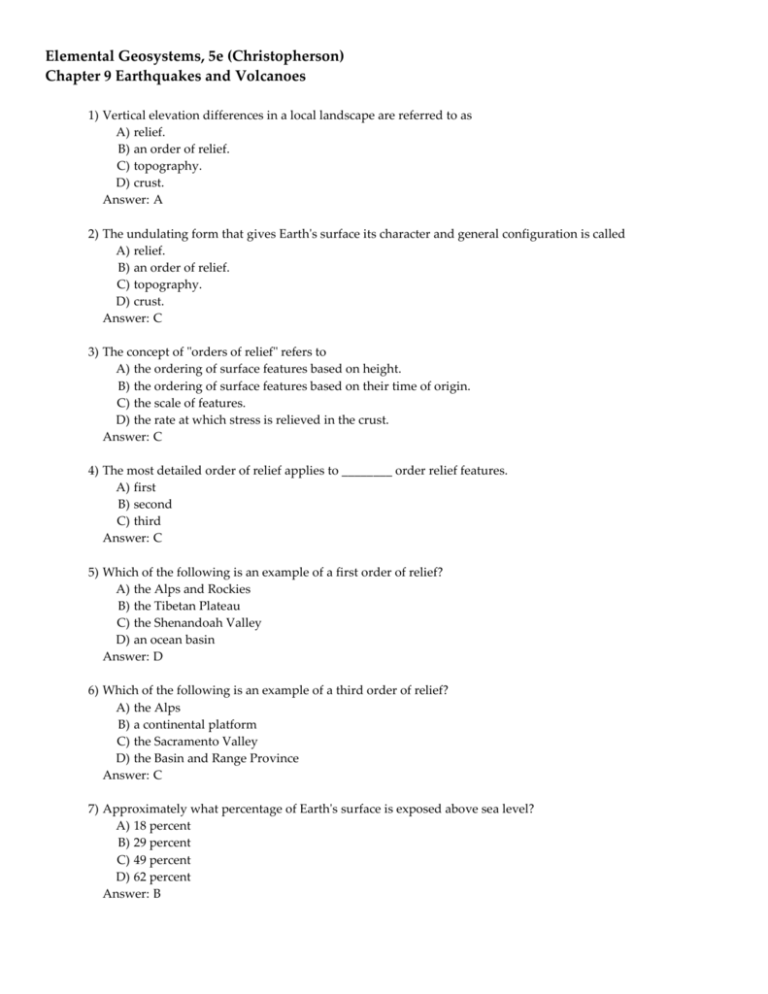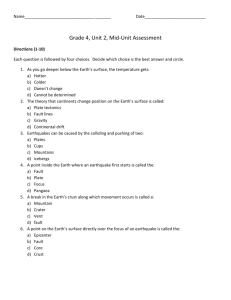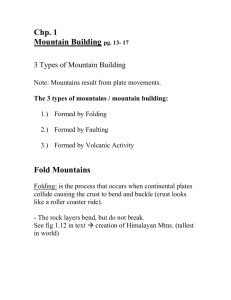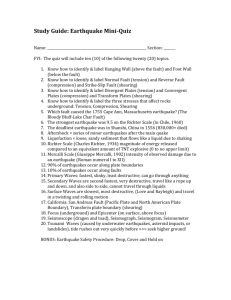Elemental Geosystems, 5e (Christopherson)
advertisement

Elemental Geosystems, 5e (Christopherson) Chapter 9 Earthquakes and Volcanoes 1) Vertical elevation differences in a local landscape are referred to as A) relief. B) an order of relief. C) topography. D) crust. Answer: A 2) The undulating form that gives Earth's surface its character and general configuration is called A) relief. B) an order of relief. C) topography. D) crust. Answer: C 3) The concept of "orders of relief" refers to A) the ordering of surface features based on height. B) the ordering of surface features based on their time of origin. C) the scale of features. D) the rate at which stress is relieved in the crust. Answer: C 4) The most detailed order of relief applies to ________ order relief features. A) first B) second C) third Answer: C 5) Which of the following is an example of a first order of relief? A) the Alps and Rockies B) the Tibetan Plateau C) the Shenandoah Valley D) an ocean basin Answer: D 6) Which of the following is an example of a third order of relief? A) the Alps B) a continental platform C) the Sacramento Valley D) the Basin and Range Province Answer: C 7) Approximately what percentage of Earth's surface is exposed above sea level? A) 18 percent B) 29 percent C) 49 percent D) 62 percent Answer: B 8) The average elevation of exposed land is A) -2070 m (-6790 ft). B) 100 m (325 ft). C) 875 m (2870 ft). D) 8848 m (29,028 ft). Answer: C 9) The average elevation of Earth's total surface is A) -3800 m (-12,470 ft). B) -2070 m (-6790 ft). C) 100 m (325 ft). D) 875 m (2870 ft). Answer: B 10) The average elevation of the depth of the oceans is A) -3800 m (-12,470 ft). B) -2070 m (-6790 ft). C) 100 m (325 ft). D) 875 m (2870 ft). Answer: A 11) A hypsographic curve is A) a graph that shows the change in temperature with depth below the surface of a continent. B) a graph that shows the change in temperature with depth below the surface of the ocean floor. C) a generalized curve showing the earth's surface by elevation in relation to sea level. D) a graph that shows Earth is of relatively high relief. E) a graph that shows Earth's relief is great when compared to its diameter. Answer: C 12) Divisions among topographic regions are based on A) arbitrary criteria regarding height or other descriptive criteria that are in common use. B) complex statistical analyses of surface relief variation across the surface of the earth. C) local criteria that have never been universally recognized. D) logarithmic relationships applied to elevation. Answer: A 13) The variety of surface features on the earth results from A) tectonic activity. B) gravity. C) weathering and erosion. D) all of these Answer: D 14) A topographic region that is characterized by local relief of less than 100 m (325 ft) is considered a A) plain. B) high tableland. C) hill or low tableland. D) depression. Answer: A 15) Compared to oceanic crust, continental crust is A) denser. B) usually formed with less than 50 percent silica and is rich in iron and magnesium. C) generally more complex in content and structure. D) essentially composed of basalt. Answer: C 16) The nucleus of old crystalline rock in each of the principal continental masses is called a A) basalt mass. B) continental shield, or craton. C) mountain mass. D) composite zone. Answer: B 17) If you were paranoid of earthquakes, which of the following areas would be the safest to live? A) convergent plate boundary B) divergent plate boundary C) island arc along a subduction zone D) shield Answer: D 18) Terranes refer to A) the topography of a tract of land. B) the "lay of the land." C) displaced and migrating pieces of Earth's crust. D) the continental shields within each continent. Answer: C 19) Which of the following is not true of terranes? A) They are smaller-scale migrating crustal pieces, i.e., microplates. B) They may accrete onto continents and thereby increase the size of the continents. C) They are framed by fracture zones. D) They are very similar in composition to the continents to which they attach. E) They can move thousands of miles from their place of origin. Answer: D 20) Which of the following is incorrectly matched? A) strain stress-induced B) compression shortening or folding C) tension stretching or faulting D) shearing stretching or faulting Answer: D 21) A brittle rock is likely to respond to stress by ________, whereas a ductile rock is likely to respond by ________. A) stretching; breaking B) breaking; bending C) isostatically uplifting; bending D) isostatically uplifting; breaking Answer: B 22) Which of the following represents a surface feature whose relief is opposite that expected based on the fold pattern in the rocks of which it is composed? A) synclinal valley B) synclinal ridge C) inverted anticline D) synclinal basin Answer: B 23) Folded layers of rock can form a wavelike pattern of troughs and crests. The layers near the trough form A) a syncline. B) a tension zone. C) an anticline. D) a thrust fault. Answer: A 24) Folded layers of rock can form a wavelike pattern of troughs and crests. The layers near the crest form A) a syncline. B) a tension zone. C) an anticline. D) a thrust fault. Answer: C 25) High mountains consisting of tightly folded and overthrust sedimentary rock layers, as well as metamorphic rocks, are formed A) along midocean ridges during seafloor spreading activity and are subsequently uplifted above sea level in response to isostatic processes. B) during plate collisions. C) during volcanic eruptions. D) in continental rift zones. E) exclusively by magma intrusions. Answer: B 26) The greatest amount of crustal shortening would be associated with A) a synclinal ridge. B) a thrust fault. C) an overturned anticline. D) a rift zone. Answer: B 27) Warping produces bends in rocks that are ________ those produced by folding. A) larger than B) smaller than C) the same size as Answer: A 28) Which of the following is a cause of warping? A) mantle convection B) hot spots C) isostatic adjustment D) all of these Answer: D 29) When rock strata are strained beyond their ability to remain an intact unit, displacement occurs in a process known as A) folding. B) faulting. C) broad warping. D) stressing. Answer: B 30) Fault types are defined by A) the relative motion of the hanging wall and footwall. B) the amount of movement along the hanging wall and footwall. C) the amount of energy liberated during movement. D) all of these Answer: A 31) Tensional stress along a fault can result in a dropped hanging-wall block relative to the footwall side, producing a A) reverse fault. B) thrust fault. C) normal fault. D) strike-slip fault. Answer: C 32) Normal faults are associated with A) tensional forces. B) compressional forces. C) plate convergence. D) transcurrent forces. Answer: A 33) Compressional stress along a fault can result in a dropped footwall block relative to the hanging-wall side, producing a A) reverse fault. B) lateral fault. C) normal fault. D) strike-slip fault. Answer: A 34) The San Andreas system in California is an example of a A) strike-slip fault. B) transform fault. C) right-lateral motion. D) All of these are correct. Answer: D 35) People often say that California is going to "fall into the ocean,". This idea is totally wrong because the San Andreas fault would have to be a __________ fault associated with __________ forces for this to happen. A) normal; tension B) normal; compression C) reverse; tension D) reverse; compression E) strike-slip; compression Answer: A 36) Which of the following is not produced by normal faulting? A) the Himalayas B) the Basin and Range C) the East Africa rift zone D) the Death Valley graben Answer: A 37) The Basin and Range Province in the western U.S. is a result of ________ faulting produced by ________ forces. A) reverse; tensional B) reverse; compressional C) normal; tensional D) normal; compressional Answer: C 38) The presence of horsts and grabens indicates the occurrence of A) volcanic activity. B) rift activity. C) collision activity. D) strike-slip activity. Answer: B 39) Orogenesis refers to A) the beginning of extensive faulting. B) a general term for the beginning of a mountain-building episode that thickens continental crust. C) a general thinning of the crust. D) the formation of mountains without faulting, folding, or the capture of migrating terranes. Answer: B 40) Which of the following can lead to the formation of mountains? A) plate collisions and volcanic activity B) exposure of plutons by erosion of surrounding landscape C) faulting D) all of the above E) plate collisions, volcanic activity, and faulting only Answer: D 41) The Grand Tetons best represent a A) horst. B) graben. C) tilted fault block. D) anticline. Answer: C 42) Because of the processes responsible for the formation of the Himalayan Mountains, the crust in this region of the world has been A) shortened. B) extended. C) folded. D) extended and folded. E) shortened and folded. Answer: E 43) The Appalachians formed as a result of the A) Laramide orogeny. B) Alleghany orogeny. C) Cordilleran orogeny. D) Alpine orogeny. Answer: B 44) The motion of seismic waves is initiated in a subsurface location along the fault plane called the A) epicenter. B) fault area. C) Richter zone. D) focus. Answer: D 45) The area at the surface directly above the subsurface location where seismic waves are initiated is termed the A) epicenter. B) fault area. C) Richter zone. D) focus. Answer: A 46) Small areas of high strain along a fault are termed A) asperities. B) focal points. C) elastic spots. D) sticking points. Answer: A 47) Foreshocks may be caused by A) the breaking of some asperities before the main movement occurs. B) small movements that occur when some rocks break in limited areas of a fault plane prior to the main movement. C) a limited number of lapilli breaking prior to the main movement. D) the breaking of asperities and small movements prior to the main movement only. E) all of these Answer: E 48) Seismic gaps investigations involve A) the study of surface cracks following an earthquake. B) paleoseismology and the history of activity along specific plate boundaries. C) perceptual studies by sociologists. D) the study of places where volcanoes have occurred. Answer: B 49) An instrument used to record vibrations in the crust is the A) land barometer. B) seismograph. C) the Richter scale. D) tiltmeter. Answer: B 50) The most active tectonic regions of North and South America are on the A) western coasts. B) eastern coasts. C) southern coasts. D) mid-continent. Answer: A 51) Which of the following is true regarding the moment magnitude scale a scale which quantifies the amount of energy released by an earthquake? A) It is a scale of magnitude based on arithmetical progressions (1,2,3,4, etc.). B) It is a closed scale that begins at 0.0 and ends at 10.0. C) An 8.0 on the scale is equal to 31.5 times more energy release than a 7.0. D) It is the same as the Mercalli scale. Answer: C 52) The wave amplitude associated with a magnitude 8 quake on the Richter scale is how many times greater than that of a magnitude 6 quake? A) 3 B) 30 C) 100 D) 1,000 E) 1,000,000 Answer: C 53) A scale used to classify and describe the effects of earthquakes on terrain, construction, and local damage conditions is the A) Richter scale. B) seismograph scale. C) seismic assessment scale. D) modified Mercalli scale. Answer: D 54) On average, how often would you expect an earthquake of greater than Richter 8.0 and Mercalli XII to occur? A) 120 times a year B) 800 times a year C) only once every few years D) once or twice a century Answer: C 55) The phrase "considerable-to-serious damage to buildings" would be used in the ________ scale. A) Richter B) Mercalli C) Beaufort D) Moh's Answer: B 56) On average, how often would you expect an earthquake of between moment magnitude 5.0-5.9 and Mercalli V-VII to occur? A) 120 times a year B) 800 times a year C) only once every few years D) once or twice a century Answer: B 57) Which of the following is not used to rate an earthquake on the moment magnitude scale? A) the amount of fault slippage that occurred B) the size of the subsurface or surface area that ruptured C) the amount of death and destruction that occurred D) the nature of the ground materials affected by the quake Answer: C 58) The greatest loss of human life (250,000) this century resulted from which earthquake event? A) northern Peru, 1970 B) Mexico City, 1985 C) Tangshan, China, 1976 D) Armenia (formerly USSR), 1988 Answer: C 59) Which of the following is incorrect regarding the series of earthquakes in southern California in 1992? A) A series of three strong earthquakes followed months of foreshocks and activity. B) Earthquakes struck that ranged in magnitude from 6.1 to 7.4 on the Richter scale. C) Earthquakes followed at epicenters across the western U.S. D) The sequence did not involve the San Andreas fault system. Answer: D 60) The major impact of earthquake prediction on a region would be A) a decline in business activity and damage to the local economy. B) increased business activity. C) an increase in property values. D) upward changes in employment opportunities. Answer: A 61) The North Anatolian fault in Turkey and the San Andreas fault in California are ________. A) left-lateral, strike-slip faults B) right-lateral, strike-slip faults C) right-lateral, transform faults D) faults with completely different motions E) right-lateral, strike-slip, transform faults Answer: E 62) Molten rock that pours forth on Earth's surface is called A) metamorphic. B) magma. C) intrusive. D) lava. Answer: B 63) Which of the following is incorrect relative to the principal locations of volcanic activity? A) They occur along sea-floor spreading centers. B) They occur around the perimeter of the Atlantic Ocean basin. C) They occur in association with hot spots over plumes in the mantle. D) They occur in the circum-Pacific belt. Answer: B 64) Effusive eruptions are not related to which of the following? A) magma with a 50 percent or lower silica content, rich in iron and magnesium B) low-viscosity magma C) magma with a 50-75 percent silica content, high in aluminum D) the volcanic activity in Hawaii Answer: C 65) Explosive eruptions tend to build up A) shield-shaped volcanoes. B) plateau basalts. C) composite volcanoes. D) many subsequent lava flows. Answer: C 66) Pulverized rock and clastic materials ejected violently during an eruption are called A) cinders. B) explosive debris. C) tephra, or pyroclastics. D) volcanic ash. Answer: C 67) Which of the following statements about shield volcanoes is true? A) They occur in shield areas of the earth. B) They are subject to violently explosive eruptions. C) They form from mafic magma. D) They consist of tremendous quantities of pyroclastics. Answer: C 68) Which of the following is not the result of extrusive volcanic activity? A) batholith B) lava flow C) tephra D) volcanic cone Answer: A 69) Volcanic activity located away from plate boundaries is associated with A) subduction and melting of plates along collision zones. B) hot spots. C) rift zones. D) all of the above Answer: B 70) A cinder cone is formed from relatively ________ viscosity magma with a ________ gas content. A) high; high B) high; low C) low; high D) low; low Answer: C 71) Volcanoes formed from silica-rich magma A) have gently sloping surfaces that give them the appearance of a shield. B) are highly explosive and dangerous. C) are associated with midocean ridges. D) are associated with rift zones. Answer: B 72) Lava plateaus, such as the Columbia River Plateau, are formed from ________ magma, which has a ________ viscosity. A) granitic; high B) granitic; low C) basaltic; high D) basaltic; low Answer: D 73) Many of the islands of Indonesia (Java, Sumatra, Borneo), which are located adjacent to a subduction zone next to the edge of the continental shelf of SE Asia, consist of felsic lava. This means that the lava that produces these islands is derived from A) a midocean ridge. B) a volcanic hot spot under the ocean floor. C) the melting of continental shelf material along with ocean floor material. D) the melting of subducted plate material and nothing else. E) a rift zone. Answer: C 74) Composite cones have steep slopes and experience ________ eruptions because they are composed of ________ magma. A) mild; mafic B) mild; felsic C) violent; mafic D) violent; felsic Answer: D 75) The eventual catastrophic eruption of Mount Saint Helens was A) a total surprise. B) within only a few days of the first earthquake. C) not preceded by any physical activity. D) related to seafloor subduction at the west coast of North America. Answer: D 76) Concerning Mount Saint Helens, which of the following is not correct? A) The Cascades lie over an area of subduction of the Juan de Fuca plate. B) It is the youngest and smallest of the Cascade Range. C) It is an example of a shield volcano in form. D) The 18 May eruption resulted in less than 100 deaths. Answer: C 77) Which of the following is true regarding harmonic tremors? A) They are associated with the sharp release of energy when two pieces of land move against each other, as along a fault. B) They are produced by sub-surface movement of magma beneath a volcano. C) They are associated with movements in the crust caused by cities and traffic. D) They are produced by explosive volcanic eruptions. Answer: B 78) Geologically speaking, the continents began forming relatively recently. Answer: True False 79) The topography of the earth's surface has had relatively little influence on human activities and culture. Answer: True False 80) The Alps and alpine complex in Europe are an example of a third order of relief. Answer: True False 81) Continental shields, or cratons, are generally of low elevation and old in age. Answer: True False 82) Ductile rocks are more likely to bend in response to stress than are brittle rocks. Answer: True False 83) Oil and gas tend to concentrate in the low areas of a fold, i.e., near the bottom of a syncline. Answer: True False 84) The San Andreas fault is principally the result of compressional stress. Answer: True False 85) The Basin and Range Province of the interior western United States is a type of horst and graben topography. Answer: True False 86) The hanging wall moves down in a reverse fault. Answer: True False 87) California has overridden part of a seafloor spreading zone. Answer: True False 88) Orogenesis can involve the capture of migrating terranes. Answer: True False 89) The Appalachians are older than the Rockies. Answer: True False 90) In order for a batholith to become a mountain, thousands of feet of sedimentary rock may have to be eroded to expose the batholith. Answer: True False 91) All earthquakes rated using the revised Richter moment magnitude scale have been rated higher than those rated on the original Richter scale. Answer: True False 92) An earthquake with a high rating on the Richter scale can receive a low rating on the Mercalli scale. Answer: True False 93) Some parts of the San Andreas are currently experiencing a seismic gap, which means that there is very little risk of a major quake in the next few decades. Answer: True False 94) The San Andreas fault in California and the North Anatolian fault in Turkey are both right-lateral, strike-slip faults. Answer: True False 95) History seems to teach us that humans are generally unable or unwilling to perceive hazards in a familiar environment. Answer: True False 96) The Hawaiian Islands are near one end of a hot-spot track that stretches to Alaska. Answer: True False 97) The Sierra Nevada and Grand Tetons are examples of tilted-fault block mountain systems. Answer: True False 98) A tall, conically-shaped volcanic peak is generally the result of effusive eruptions. Answer: True False 99) Scientists feel they have identified all the major faults underlying the Los Angeles region. Answer: True False








